
The Bell XV-15 is an American tiltrotor VTOL aircraft. It was the second successful experimental tiltrotor aircraft and the first to demonstrate the concept's high speed performance relative to conventional helicopters.

The Kamov Ka-26 is a Soviet light utility helicopter with co-axial rotors.
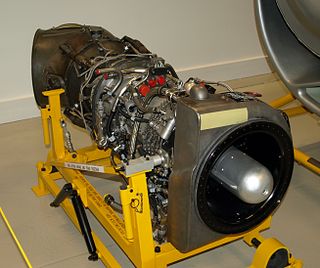
The Rolls-Royce Gnome is a British turboshaft engine originally developed by the de Havilland Engine Company as a licence-built General Electric T58, an American mid-1950s design. The Gnome came to Rolls-Royce after their takeover of Bristol Siddeley in 1966, Bristol having absorbed de Havilland Engines Limited in 1961.

The Bell 204 and 205 are the civilian versions of the UH-1 Iroquois single-engine military helicopter of the Huey family of helicopters. They are type-certificated in the transport category and are used in a wide variety of applications, including crop dusting, cargo lifting, Forestry Operations, and aerial firefighting.

The Agusta A.115 was a prototype helicopter flown in 1961 in Italy. It was essentially a Bell 47J-3 with an unclad, tubular tail boom, and powered by a Turbomeca Astazou II turboshaft engine. No production ensued.

The Agusta A.103 was an Italian prototype single-seat light helicopter flown in October 1959. The pilot was enclosed by a perspex bubble with the engine at the rear and the tail rotor carried on an enclosed boom.

The Agusta A.104 Helicar was an Italian prototype light commercial helicopter first flown in December 1960.

The Agusta A.106 was a single-seat light helicopter designed to provide an anti-submarine warfare (ASW) platform for the Impavido-class destroyers of the Italian Navy. The aircraft was provided with a sophisticated electronics suite by Ferranti for autostabilisation and contact identification. Two torpedoes could be slung under the fuselage. The tail and two-bladed main rotor could be folded for shipboard stowage, and the skid undercarriage had fittings for flotation bags.

The Agusta AZ.8L, or Agusta-Zappata AZ.8L, was an Italian airliner prototype first flown on 9 June 1958. It was of conventional low-wing monoplane configuration with tricycle undercarriage and all-metal construction. Filippo Zappata's design grew out of a twin-engined transport designated AZ.1 that was never built.
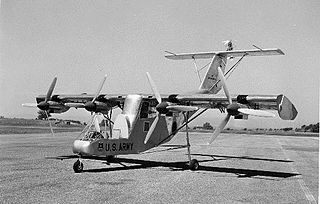
The Fairchild VZ-5 was an experimental VTOL aircraft built in the 1950s. The VZ-5 was designed by Fairchild Aircraft for research use by the United States Army.
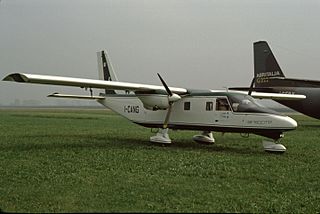
The Vulcanair SF.600 Canguro was a feederliner developed in Italy in the late 1970s. Despite a number of attempts to put the aircraft into series production, only a small number were ever built. The Canguro was a high-wing cantilever monoplane of conventional configuration with a fuselage of rectangular cross-section and a high-set tail. The tricycle undercarriage was not retractable, and its main units were carried on sponsons on the fuselage sides. SIAI Marchetti provided funding towards the construction of the prototype, and constructed this aircraft at the former Aviamilano plant. After flight testing proved positive, the type was put on sale, but failed to attract buyers in any number, even when the original piston engines were exchanged for turboprops and retractable undercarriage was offered as an option.

The Yakovlev EG (Eksperimentalnyi Gelikopter), also commonly known as the Yak-M11FR-1 and Sh (Shootka), was an experimental aircraft with coaxial rotors. The prototype was first flown by V.V. Tezavrovsky in December 1947.
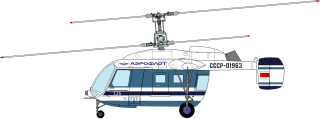
The Kamov Ka-126 is a Soviet light utility helicopter with co-axial rotors. Evolved from Ka-26 with engine pods removed from stub wings, fitted with one TVO-100 turboshaft engine positioned on top of fuselage, modified rotor blades, new fuel system.
The American Aircraft Penetrator, now referred as the Aerocraft Stealth Star 204 SS, was a gunship helicopter modified from the Bell UH-1B Iroquois with tandem seating for the pilots and a troop-carrying compartment.
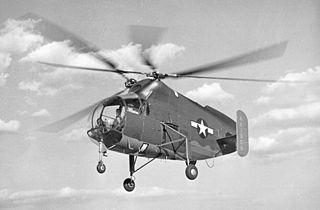
The Kellett XR-8 was a helicopter built in the United States during World War II. It was a two-seat machine intended to demonstrate the feasibility of a twin-rotor system and, while it accomplished this, it also demonstrated a number of problems that prevented further development of this particular design.

The Kellett XR-10 was a military transport helicopter developed in the United States in the 1940s that only flew in prototype form. It was designed in response to a USAAF Technical Instruction issued for the development of a helicopter to transport passengers, cargo, or wounded personnel within an enclosed fuselage. Kellett's proposal followed the general layout that the company was developing in the XR-8, with twin intermeshing rotors, and was accepted by the Air Force on 16 October over proposals by Sikorsky, Bell, and Platt-LePage.
The Meridionali/Agusta EMA 124 was a light utility helicopter flown in prototype form in Italy in 1970. The design was undertaken by Agusta for production in a joint venture with Elicotteri Meridionali, based on the Bell 47 that Agusta was building under licence at the time.

The Agusta A.105 was an Italian rotorcraft designed by Agusta. It was never developed beyond the prototype stage.
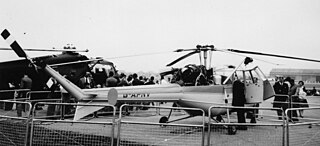
The Saro P.531 is a British all-metal five-seat helicopter designed and built by Saunders-Roe Limited (Saro). The P.531 was a larger development of the two-seat Saro Skeeter to use turbine power and formed the basis of the military Westland Scout and Westland Wasp helicopters.
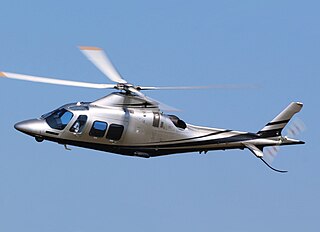
The AgustaWestland AW109S Grand is a lightweight, twin-engine, eight-seat multi-purpose helicopter built by the Italian manufacturer AgustaWestland. This rotorcraft has been developed from AgustaWestland AW109 by lengthening the cabin and main rotor blades with different tip design. The Agusta Grand is fitted with two Pratt & Whitney Canada PW207C engines whereas its predecessor AW109E has two Pratt & Whitney Canada PW206C engines. It originally entered service in 2005 and has since been used in various roles, including light transport, medevac, search-and-rescue, and military roles.



















